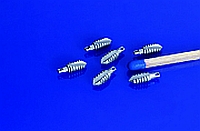Fewer surgeries with degradable implants

Until now, in cases of bone fracture, doctors have used implants made of steel and titanium, which have to be removed after healing. To spare patients burdensome interventions, researchers are working on a bone substitute that completely degrades in the body. Towards this end, material combinations of metal and ceramic are being used. From November 12 to 14 the demonstrator of a suture anchor will be shown at the COMPAMED 2014 trade fair in Düsseldorf (Hall 8a, Stand K 38).
No other joint in the human body is as highly mobile as is the shoulder. However, it is also very sensitive and prone to injury, with athletes being particularly affected. The most common complaints include tendon rupture, which have to be treated surgically. The surgeon fastens the cracks using suture anchors. Such implants used to be made of titanium or non-degradable polymers – with the disadvantages that either they remain in the body even after healing has occurred or doctors have to remove them in a second procedure. To avoid this, researchers at the Fraunhofer Institute for Manufacturing Technology and Advanced Materials IFAM in Bremen have developed load bearing, biodegradable implants that are completely degraded in the body. In the first step, they have used powder injection molding to manufacture a suture anchor, which is available as a demonstrator. The researchers will present it from November 12th to 14th at the COMPAMED trade fair in Düsseldorf.
Calcium phosphate stimulates the healing process of the bone
“With the implant, severed tendons can be anchored to the bone until they have grown again. Since the function of the fi xing element is satisfied after the healing process, it is no longer needed in the body. If implants or protheses that are as wear resistant as possible are required – such as in an artificial hip joint – metallic alloys such as titanium will certainly continue to be used. However, for plates, screws, pins and nails which should not remain in the body, there are other requirements,” says Dr. Philipp Imgrund, manager of the Medical Technology and Life Sciences business field at IFAM. In the project “DegraLast”, IFAM has worked jointly with the Fraunhofer Institutes for Laser Technology ILT, for Biomedical Engineering IBMT and for Interfacial Engineering and Biotechnology IGB in establishing a materials and technology platform to produce degradable bone implants for use in trauma surgery and orthopedics. These materials are to be gradually absorbed by the body while, at the same time, new bone tissue is formed. Ideally, the degree of degradation is adapted to the bone growth so that the degradation of the implant meshes with the bone formation. For this reason, the scientists are developing materials with specifically adjustable degradation. The challenge: The implants have to be mechanically stable enough during the entire healing process so that they are able to fix the bone in place. At the same time, they cannot have any allergenic effects or cause inflammation. The researchers at IFAM are relying on metal-ceramic composites. A metal component based on an iron alloy is being combined with beta-tricalcium phosphate (TCP) as the ceramic component. “Iron
alloys corrode slowly and ensure high mechanical strength, while ceramic decomposes quickly, stimulates bone growth and aids the ingrowth of the implant”, Imgrund says to explain the advantages of this material combination.
In order to be able to manufacture the material composite, the researchers have turned to the powder injection molding process. It offers the ability to produce complex structures cost-effectively and in large numbers. Properties such as density and porosity can be controlled selectively – an important factor, since high density and low porosity result in high mechanical strengths. Another advantage: The materials are available as
powders and can be mixed in any proportion prior to processing. But what proportion is the right one? In laboratory experiments, the researchers have found the optimum composition of the materials for the suture anchor. The demonstrator consists of 60 percent iron and 40 percent ceramic. “It is important to determine the right amount of ceramics as a function of the powder amount. If the proportion is too high, the material will be brittle. On the other hand, the tricalcium phosphate accelerates the degradation
of the implant,” says Imgrund. The researchers have succeeded in doubling
the degradation rate from 120 to 240 micrometers per year in the laboratory model. The shoulder anchor would be absorbed by the body within one to two years.
While shaping processes such as powder injection molding are especially suited in large quantities as fixation elements for standard implants, additive manufacturing methods are used to produce individual implants – such as for bone replacement in the skull area – or implants with defined pore structure. The researchers from ILT who are also involved in the project are producing implants made of magnesium alloys through the use of Selective Laser Melting (SLM). To ensure the safety of the novel composite materials
from the outset, colleagues from IGB in the “DegraLast” project are establishing cell-based in-vitro test systems for analysis of the ingrowth behavior in the bone. The scientists at IBMT are in turn working on an in-vivo monitoring system that can monitor and document the degradation behavior of the implants in the human body.
Last modified:
 Fraunhofer Institute for Manufacturing Technology and Advanced Materials IFAM
Fraunhofer Institute for Manufacturing Technology and Advanced Materials IFAM